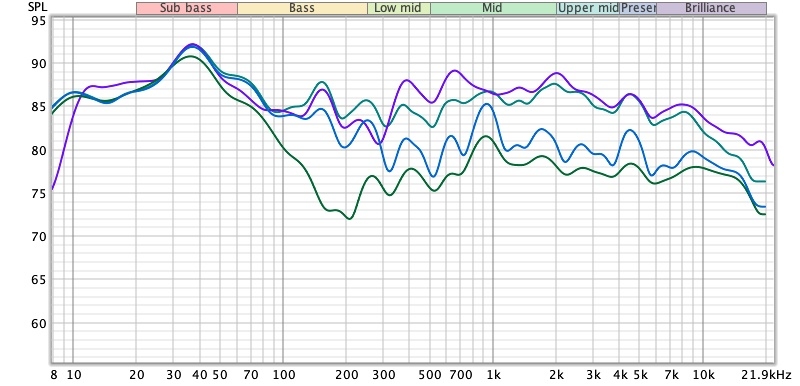Retained
-
Member Title
Banned Troll
Personal Information
-
Location
UTC+1
Recent Profile Visitors
9376 profile views
-
messing with LS at different levels + compensation, I settled for something that is cleaner as a 12 dB HRR target. When beefier is welcome... Harman 12dB RMS corrected (1).txt
- 12 replies
-
Right BUT... Let's say I want an in room response resembling Harman's RR1. I suppose (haven't found anything written) that it applies to Steady State for it Low End extends B&K that implies PN + RTA measures, no time-window, no Impulse. So considering MMM as basis makes sense BUT... Here is what happens when applying the convolution impulses obtained by aligning FDW VA to a extended by 1.8 dB @ 100 Hz Low Shelve HRR to the NON FDWed RMS average. There is more presence and brillance that if I perfectly aligned MMM or the close to it NON FDWed RMS average and to my ears it's better. The thing is that though MMM yields faster highly reproductible results it's not (anymore for me) the most desirable basis to work on because the peaks and dips it measures are steady-state's and not the ones that really matter, the ones that matter happen early. So here was the predicament: I assume the earliest measures of what happens in my room are given by REW's FDWed VA so I wanted to use REW's FDWed VA not only for Time domain but for Amplitude as well ; but nowhere in the literature have I found a saying of which target curves to apply to REW's FDWed VA. So this thread is about sharing my findings : aligning REW's FDWed VA to 10 dB HRR (.txt attached above) yields results consistent with targets of fame : EBU that is to be PN+RTA done and, and, when extended 1.8 DB LS @ 100 Hz, RR1, both on RMS average (or MMM). You might have noted that RR1 fits VA alignement to HRR convolution x FDW RMS Av & VA alignement to 1.8 dB extended HRR convolution x NON FDWed RMS Av. I frankly don't know if RR1 as presented by Harman pertains to FDW or NON FDWed for they don't say. Yet, Harman literature mentions taking advantage of time-windowed measures. Maybe, most probably, their much more controlled rooms exhibit closer FDW and non FDW measures. I don't know. What I can tell is that switching between both allows me to be happy whatever I listen to, for the moment...
- 12 replies
-

HQPlayer Linux Desktop and HQplayer embedded
Le Concombre Masqué replied to ted_b's topic in Software
@Miska Hi Miska, I have experimental sets of convolution in Matrix and Delete does not work (4.18.01) : even after a restart they are still listed -
Yes. The nice thing is that it yields highly reproductible results (eventually including artefacts, I recommend using a 6 foot broom stick to avoid interaction with your body). But no Impulse Response. So you need to Vector Average sweeps anyway. Impulse is not as neat because of slight shifts plus, big thing, it does not take advantage of Time Windowing that allows to extract Direct Sound and first arrivals from the Data.
- 12 replies
-
Absolutely. This would be my answer to your post #17853; thank you, I'm looking forward to reading your findings
-
To wrap it up: To my ears convolutions built upon REW's FDW VA yield better results. Issue dealt with here is : what target curve should be applied to it? The usual suspects such as B&K or EBU that suppose a Steady State measurement by the use of Pink Noise and RTA just don't apply. In my room, aligning REW's FDW VA to a 10 dB Harman Reference Room Target yields convolution impulses that align RMS Average to EBU 3276 and FDW RMS Average to Harman's RR1, give or take 3 dB peaks or dips*. Aligning REW's FDW VA to a 10 dB Harman Reference Room extended by 1.8 dB @ 100 Hz Low Shelve Target yields convolution impulses that align FDW RMS Average to Harman's JBL SYNTHESIS. For those who would rather use donation free softwares REW and RePhase rather than paying for a commercial design software**, I thus recommend aligning REW's FDW VA to a 10 dB Harman Reference Room, extended and non extended, Target in order to get 2 sets of convolution filters. *Not only my room has an asymmetrical distribution of windows, doors and furniture but reverberation absorption etc are just as is in a non treated room. ** They might or might not implement under the hood NON WYSIWYG tricks, and that would be for the better as far as sonic results are concerned, but then it feeds a confusion that hasn't to be.
- 12 replies
-
Here is what happens when applying the convolution impulses obtained by aligning FDW VA to a extended by 2dB @ 100 Hz Low Shelve HRR to the FDW RMS average. There are obviously peaks that differ because of the VA computation but JBL Synthesis target fits it.
- 12 replies
-
The above statement might be accurate per se but aligning FDW VA to HRR could be considered as an alternate method to meet EBU Tech. 3276's operational room response curve. Good reasons for favouring it over aligning measurements made with 1/3–octave filtered pink noise include more relevant measurements, thanks to sweeps, thanks to VA computation, as well as vastly improved Time Domain. Following the general principle of reducing the circle of confusion, that works better with masterings following EBU Tech. 3276's recommendations ; makes sense with classical productions by the main labels. But not limited to...
- 12 replies
-
I have not used the expression room correction so far. Indeed, when I actually apply HRR to FDW VA I lower very much the target level (at lowest dip level), sculpting the response in a raw block. Harman literature evokes a “circle of confusion” : the Art being created with a supposed CD/download buyer's listening environment, the circle is reduced when the Art is reproduced in the environment it was created. I have actually met one single curve dubbed as a target by people doing research : the JBL Synthesis by Harman. Attached here. It’s easy to see if you introduce it in REW and compare it to BK or RR1 or HRR, that the spread, the “distance” between 20 and 20 K is about 3 dB wider, minimum. Works well with stuff mastered by Bernie Grundman. Nowadays, I have 3 convolution sets at hand : designed by aligning FDW VA to HRR, designed by aligning RMS Av to RR1, designed by aligning RMS to JBL Synthesis with the one designed by aligning FDW VA to HRR as GO TO to start with and the one designed by aligning RMS to JBL Synthesis as second best guess. Harman Curve M2SYNTH.txt
- 12 replies
-
Here is what happens when applying the convolution impulses obtained by aligning FDW VA to HRR to the RMS average. There are obviously peaks that differ because of the VA computation but a target flat to 2 KHz with the downward tilt above fits it while I don’t like at all the results obtained when creating convolution filters that align RMS Av on such a target.
- 12 replies
-
Here is what happens when applying the convolution impulses obtained by aligning FDW VA to HRR to the FDW RMS average. There are obviously peaks that differ because of the VA computation (and thus what is looked at is different) but RR1 fits it while I don’t like at all the results obtained when creating convolution filters that align FDW RMS Av on RR1. These are not actual measures but REW simulations have a good track record of exacting. Note : I can easily push buttons to flat down to 10 Hz but prefer to respect the natural attenuation of my speakers below 30 Hz
- 12 replies
-
Here I decide to correct Amplitude on the Vector Average Nowhere in the literature have I found Harman or REW stating that the Harman Reference Room (attached) is the target to apply to FDW VA. Yet it’s my understanding that HRR is the predicted response with Room Gain when you put a flat measuring in anechoic chamber speaker in an ideal room ; and that REW’s FDW VA computes the First Arrivals that should in theory resemble HRR. I may be wrong but it looked promising enough to give it a try. To my ears, in my room with my Full Range active speakers, results are spooky with such as Stereophile CD 3’s Microphone Techniques track. In general it does wonders with acoustic recordings with amazing soundstages while it often sounds too surgical with Pop and so. If you give this a try, mind to correct the amplitude in RePhase (serious discrepancies with REW in the steep raise region) Harman 10dB RMS corrected.txt
- 12 replies
-
Here are some itching funnies (and ready made for REW targets) I’d like to share. First, Let’s take the same set of Impulse Responses obtained by Sweeps and average* them 3 ways in REW : Frequency Dependent Windowed RMS Average, RMS Average, FDW Vector Average. I add results from Real Time Analysis of Pink Noise measured while Moving Microphone. There have been some changes between MMM and Sweeps times but still there’s a good consistency between RMS Av and MMM results while FDW RMS Av and FDW VA yield radically different results, in my room with my speakers. Hence, you’d better know what you (or the expert and/or commercial software you would trust) are/is to pick. If I am to obtain textbook Impulse and Step Response (thanks to RePhase) I have to pick the FDW VA. If I set Phase with the FDW VA and then set Amplitude on RMS Av or MMM, Impulse and Step remain OK but not as pretty. This raises the question of what but the VA is a commercial software picking if it is to display textbook Phase related results. And that conflicts, unless What You See is Not What You Get, with the choices of targets (neither B&K nor Harman dubbed them such) such as RR1 or B&K. RR1 low end extends B&K that dates back to Pink Noise and RTA time, so no Impulse Response, no FDW, it’s Steady State that is measured… So, if one is to choose a target related to Steady State, one should better apply it on Steady State measurement… *L and R are in different environments in my room and hence measure differently below 300 but for the sake of simplicity they are here added/averaged
- 12 replies
-

Article: CAPS Twenty | Part One
Le Concombre Masqué replied to The Computer Audiophile's topic in Article Comments
Pardon me then for I was far far away of awareness that a GPU was required for a NAA endpoint and furthermore that its load (and CPU's and RAM's) monitoring was critical... -

Article: CAPS Twenty | Part One
Le Concombre Masqué replied to The Computer Audiophile's topic in Article Comments
what do the gorgeous gauges read then ? the CPU GPU etc load of the endpoint or of the horsepower PC ?










